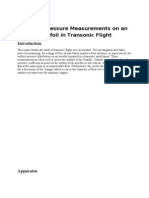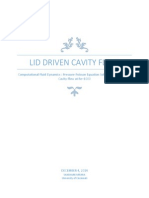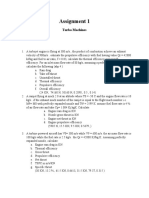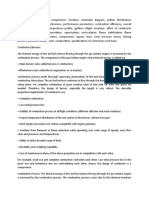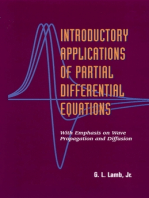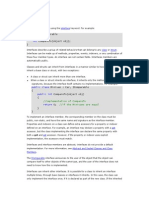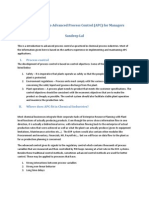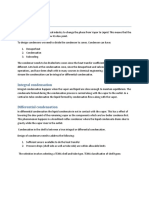Elbow Flow Measurement
Elbow Flow Measurement
Uploaded by
sandeep lalCopyright:
Available Formats
Elbow Flow Measurement
Elbow Flow Measurement
Uploaded by
sandeep lalOriginal Description:
Copyright
Available Formats
Share this document
Did you find this document useful?
Is this content inappropriate?
Copyright:
Available Formats
Elbow Flow Measurement
Elbow Flow Measurement
Uploaded by
sandeep lalCopyright:
Available Formats
Elbow Flow Measurement
Flow measurement is very important in pretty much any application. In chemical industries, since
material is bought and sold by the total amount, it directly influences the economics. Moreover, within
the manufacturing process, streams are directly controlled to enable better control of the process. To
make material flow it takes energy, e.g. compressors are used for gas and pumps for liquids and
conveyor belts for solids.
Theory
When a flowing fluid changes direction like due to a bend in the pipe, there is a pressure difference that
results from the centrifugal force generated. This pressure difference is proportional to the flow of fluid.
By measuring the pressure differential the flow can be inferred.
Advantages/Disadvantages
Since pipe elbows are there is a plan, the cost is minimal. Another advantage is that this can measure
fluids that have suspended solids, slurries etc…. There is minimal pressure drop as in the venture or the
most popular “orifice” flow meters. The only disadvantage is that the accuracy is not very good.
Typical flow meter
High Pressure Tap
Low Pressure Tap
Theory
Flow of a fluid is defined by the following equation
𝑉2
∆ 𝐻 = 𝐶𝐾
2𝑔
Where
∆H is the differential head across the bend
V is the average velocity through the elbow
Ck is a dimensionless coefficient dependent on the ratio of the center line radius R, to the cross-sectional
radius r.
X = R/r
16 𝑥
𝐶𝑘 =
𝑥+1
((𝑥 2 − 1) (𝑙𝑛 𝑥 − 1)) 2
The elbow should be installed 25 pipe diameters of straight pipe on the upstream and 10 pipe diameters
on the downstream. To install on a vertical pipe the flow of material should be up to eliminate
entrapped vapor or air.
Figure 1 – shows a typical pressure profile in a vertical elbow. Note the presence of vortex where the
boundary layer separates.
Figure 1 - Pressure profile in the elbow
Typical calibration curve is shown in Fig -2.
Calibration Curve
40
35
Differential Pressue
30
25
20
15
10
5
0
0 2 4 6 8 10 12 14
Flow
Figure 2 - Typical Calibration Curve
You might also like
- Philippine Productivity Ratios Labour Manpower RateDocument66 pagesPhilippine Productivity Ratios Labour Manpower RateLauro Paniergo100% (1)
- DataFlow Status 28-08-2023 04.30 PMDocument1 pageDataFlow Status 28-08-2023 04.30 PMالأسطورةNo ratings yet
- Design of MS Pipe Wall Thickness - Guwahati C 01Document6 pagesDesign of MS Pipe Wall Thickness - Guwahati C 01rvsingh17gmailcom100% (1)
- XFLR5 Lab 1Document33 pagesXFLR5 Lab 1maryNo ratings yet
- Ae 17412 - Aerodynamics Lab - I (Manual)Document50 pagesAe 17412 - Aerodynamics Lab - I (Manual)EZHILMARANNo ratings yet
- Transonic Report DEN 302Document17 pagesTransonic Report DEN 302get_moin50% (2)
- Homework 1Document2 pagesHomework 1Fernando AguayoNo ratings yet
- Compressible Flow Across A Varying Area PassageDocument4 pagesCompressible Flow Across A Varying Area PassageGaurav VaibhavNo ratings yet
- Formulas For Engine CycleDocument2 pagesFormulas For Engine CycleNeo GarceraNo ratings yet
- Normal ShocksDocument12 pagesNormal ShocksaeroacademicNo ratings yet
- ME 123 Lift and Drag Lab HandoutDocument11 pagesME 123 Lift and Drag Lab HandoutFanis VlazakisNo ratings yet
- Flow Analysis in A Convergent-Divergent Nozzle Using CFDDocument9 pagesFlow Analysis in A Convergent-Divergent Nozzle Using CFDsaradhi198No ratings yet
- Stress and StrainDocument6 pagesStress and StrainTugas000% (1)
- Dr. A. Aziz Bazoune: King Fahd University of Petroleum & Minerals Mechanical Engineering DepartmentDocument14 pagesDr. A. Aziz Bazoune: King Fahd University of Petroleum & Minerals Mechanical Engineering DepartmentIsmail DoğanNo ratings yet
- CH 6 Differential Analysis of Fluid Flow Part IIDocument100 pagesCH 6 Differential Analysis of Fluid Flow Part IIMujtaba RizviNo ratings yet
- Axial Flow CompressorsDocument8 pagesAxial Flow Compressorskabbilaash kumarNo ratings yet
- Aerodynamics Chapter 1 RDocument25 pagesAerodynamics Chapter 1 RYadana1No ratings yet
- Fluid Mechanics Question Bank CE8394Document34 pagesFluid Mechanics Question Bank CE8394Bala Mettur100% (1)
- P 303 AnsDocument4 pagesP 303 AnsDiptoNo ratings yet
- Friction Clutches-Study MaterialDocument11 pagesFriction Clutches-Study MaterialAnvesh HegdeNo ratings yet
- Procedure Rolling Moment Report PDFDocument12 pagesProcedure Rolling Moment Report PDFMoSamHusseiniNo ratings yet
- NTPC Anta Training ReportDocument33 pagesNTPC Anta Training Reportpradeep meenaNo ratings yet
- Delta Wing Force MeasurementDocument10 pagesDelta Wing Force MeasurementMidhu MNo ratings yet
- Hydraulic and Compressible Flow TurbomachinesDocument146 pagesHydraulic and Compressible Flow TurbomachinesPaul Healy100% (3)
- Choice of Blade Profile, Pitch and ChordDocument6 pagesChoice of Blade Profile, Pitch and Chordapi-27135468260% (5)
- UNIT II: Fuels: SyllabusDocument26 pagesUNIT II: Fuels: SyllabusMAYUR BHOSALE100% (1)
- Characteristics of PumpsDocument7 pagesCharacteristics of PumpsKhiara Claudine EspinosaNo ratings yet
- Axial Flow or Propeller PumpDocument4 pagesAxial Flow or Propeller PumpTarunPatraNo ratings yet
- Flow Around A CylinderDocument17 pagesFlow Around A CylinderMatheus PauloNo ratings yet
- Axial Compressors 2: - Blade Design - Preliminary Design of A Seven Stage CompressorDocument40 pagesAxial Compressors 2: - Blade Design - Preliminary Design of A Seven Stage CompressorKhaled YousefNo ratings yet
- CFD Analysis and Design ImpellerDocument8 pagesCFD Analysis and Design ImpellerFarooqNo ratings yet
- HM Laboratory Manual 2012Document42 pagesHM Laboratory Manual 2012Sreesh P SomarajanNo ratings yet
- Basicthermo Compiled TnshridharDocument129 pagesBasicthermo Compiled Tnshridharsohan2902No ratings yet
- Introduction To Turbomachinery Final Exam 1SY 2016-2017Document1 pageIntroduction To Turbomachinery Final Exam 1SY 2016-2017Paul Rodgers100% (1)
- Lid Driven CavityDocument24 pagesLid Driven CavityShashank MishraNo ratings yet
- CH 02Document9 pagesCH 02Ahmed M TNo ratings yet
- Department of Aeronauticalengineering Ae 2204 - Elements of Aeronautics Question Bank Part ADocument6 pagesDepartment of Aeronauticalengineering Ae 2204 - Elements of Aeronautics Question Bank Part AparathNo ratings yet
- CFD 2006 - Chapter 5 FVM For Convection-Diffusion ProblemDocument27 pagesCFD 2006 - Chapter 5 FVM For Convection-Diffusion Problembalaganesh rNo ratings yet
- Tutorial 3 - BMCF 2223 (Manometer)Document4 pagesTutorial 3 - BMCF 2223 (Manometer)Muhamad Syazwan100% (1)
- 312H Project - FinalDocument39 pages312H Project - Finalpmd5102100% (3)
- Theories of Failure - 2marksDocument2 pagesTheories of Failure - 2marksBas KaranNo ratings yet
- Thermodynamics Lab Manual - SDocument32 pagesThermodynamics Lab Manual - SGurunath AeroNo ratings yet
- m341 12 Lecture16 Boundary Layer Over Flat Plate PDFDocument15 pagesm341 12 Lecture16 Boundary Layer Over Flat Plate PDFMechanical EngineeringNo ratings yet
- Miscellaneous Strength Topics: Castigliano's TheoremDocument5 pagesMiscellaneous Strength Topics: Castigliano's TheoremDeepak Chachra100% (1)
- Assignment 1: Turbo MachinesDocument2 pagesAssignment 1: Turbo MachineskookoNo ratings yet
- Stagnation PropertiesDocument28 pagesStagnation PropertiesAmal RajNo ratings yet
- Air ConditioningDocument3 pagesAir ConditioningBoJassim100% (1)
- CM LC1Document28 pagesCM LC1Eng W EaNo ratings yet
- Lab 1a Wind Tunnel Testing Principles & Drag Coefficients of Golf BallsDocument9 pagesLab 1a Wind Tunnel Testing Principles & Drag Coefficients of Golf BallsSaadNo ratings yet
- BURNER: Burners-Types, Components - Function, Schematic Diagram, Airflow DistributionDocument14 pagesBURNER: Burners-Types, Components - Function, Schematic Diagram, Airflow DistributionSushma RajagopalNo ratings yet
- Rr312102 Aircraft PerformanceDocument8 pagesRr312102 Aircraft PerformanceSrinivasa Rao GNo ratings yet
- Module6 WorkedOut ProblemsDocument57 pagesModule6 WorkedOut ProblemsMohd HarrizNo ratings yet
- 18ME54 Turbo Machines Module 03 Question No 6a & 6bDocument9 pages18ME54 Turbo Machines Module 03 Question No 6a & 6bThanmay JSNo ratings yet
- Dke672 ch4Document43 pagesDke672 ch4Khaled SolimanNo ratings yet
- Assignment 1Document2 pagesAssignment 1nimishk92100% (1)
- AnalysisMethods SSR SSCI SSTIDocument27 pagesAnalysisMethods SSR SSCI SSTIRaturi DeepankarNo ratings yet
- Introductory Applications of Partial Differential Equations: With Emphasis on Wave Propagation and DiffusionFrom EverandIntroductory Applications of Partial Differential Equations: With Emphasis on Wave Propagation and DiffusionNo ratings yet
- Flow Meters: Diff Ilp M Differential Pressure MetersDocument11 pagesFlow Meters: Diff Ilp M Differential Pressure MeterscandyNo ratings yet
- Flow MeasurementDocument12 pagesFlow MeasurementParth MehraNo ratings yet
- Flow Measurement (Compatibility Mode)Document11 pagesFlow Measurement (Compatibility Mode)NRNiloyNo ratings yet
- Operating and ControlDocument378 pagesOperating and Controlباسم باسم100% (1)
- Persamaan Energi Dalam Aliran InternalDocument28 pagesPersamaan Energi Dalam Aliran InternalLativa Putry AFiznaNo ratings yet
- Calculations in Access QueriesDocument4 pagesCalculations in Access Queriessandeep lalNo ratings yet
- What Do I Do With This Linux BoxDocument2 pagesWhat Do I Do With This Linux Boxsandeep lalNo ratings yet
- LNG For Non Technical PeopleDocument3 pagesLNG For Non Technical Peoplesandeep lalNo ratings yet
- Interfaces in C# PDFDocument3 pagesInterfaces in C# PDFsandeep lalNo ratings yet
- Fault Detection PDFDocument2 pagesFault Detection PDFsandeep lalNo ratings yet
- Interfaces (C# Programming Guide) : Interface Icomparable (Compareto (Object Obj) )Document3 pagesInterfaces (C# Programming Guide) : Interface Icomparable (Compareto (Object Obj) )sandeep lalNo ratings yet
- Nylon 6,6Document1 pageNylon 6,6sandeep lalNo ratings yet
- Interfaces (C# Programming Guide) : Interface Icomparable (Compareto (Object Obj) )Document3 pagesInterfaces (C# Programming Guide) : Interface Icomparable (Compareto (Object Obj) )sandeep lalNo ratings yet
- 1 02 Coco PDFDocument13 pages1 02 Coco PDFsandeep lalNo ratings yet
- Ordinary Differential Equations PDFDocument2 pagesOrdinary Differential Equations PDFsandeep lalNo ratings yet
- Toolbox Weektwo PDFDocument7 pagesToolbox Weektwo PDFsandeep lalNo ratings yet
- Vapor Liquid Equilibrium CalculationsDocument4 pagesVapor Liquid Equilibrium Calculationssandeep lal0% (1)
- Dewpoint Calculation For A Multicomponent Mixture PDFDocument4 pagesDewpoint Calculation For A Multicomponent Mixture PDFsandeep lal100% (1)
- A Introduction To Advanced Process Control For ManagersDocument3 pagesA Introduction To Advanced Process Control For Managerssandeep lalNo ratings yet
- A Introduction To Advanced Process ControlDocument5 pagesA Introduction To Advanced Process Controlsandeep lal100% (1)
- Condensers: Integral CondensationDocument3 pagesCondensers: Integral Condensationsandeep lalNo ratings yet
- 2007 Jis 1 MBDocument6 pages2007 Jis 1 MBWK ChoongNo ratings yet
- Pegatron T14NH REV 2.0 (Incompleto) PDFDocument5 pagesPegatron T14NH REV 2.0 (Incompleto) PDFDmitri Petrenko100% (1)
- Special CablesDocument115 pagesSpecial Cablesjav071No ratings yet
- Focused Crawling Using Context Graphs: M. Diligenti, F. M. Coetzee, S. Lawrence, C. L. Giles and M. GoriDocument8 pagesFocused Crawling Using Context Graphs: M. Diligenti, F. M. Coetzee, S. Lawrence, C. L. Giles and M. GoriSatyam GuptaNo ratings yet
- Yamaha AMP GP Pro A Series-Disklavier III-dc3a Dc5a Dc6a Dc7a Ds4a Ds6a Dcf3sa ProDocument116 pagesYamaha AMP GP Pro A Series-Disklavier III-dc3a Dc5a Dc6a Dc7a Ds4a Ds6a Dcf3sa ProDamon Brunger100% (1)
- SCU Harvard Referencing Style - 2019 PDFDocument14 pagesSCU Harvard Referencing Style - 2019 PDFLawanNo ratings yet
- Gibilisco Quiz 10Document21 pagesGibilisco Quiz 10rhedmishNo ratings yet
- Kaydon Dry Gas SealDocument12 pagesKaydon Dry Gas Sealxsi666No ratings yet
- Telephone Etiquette: Answering CallsDocument2 pagesTelephone Etiquette: Answering CallsRICHDALE DEJITONo ratings yet
- 07861900 (1)Document84 pages07861900 (1)yilihomeNo ratings yet
- 610992Document619 pages610992Abeer El Fieky50% (2)
- 1.1 Corrosion LoopDocument2 pages1.1 Corrosion LoopRizkiNo ratings yet
- Archery - Lesson Plan: BOW and Become Link, The Future Saviour ofDocument8 pagesArchery - Lesson Plan: BOW and Become Link, The Future Saviour ofapi-375624887No ratings yet
- Manual Multidetector Dmd4Document32 pagesManual Multidetector Dmd4Alex RefrigeraçãoNo ratings yet
- Chenming Hu Ch3Document30 pagesChenming Hu Ch3Green HeartNo ratings yet
- Caja de VacioDocument1 pageCaja de Vaciojaime huertasNo ratings yet
- Delivery Challan Issue For Jobw WorkDocument1 pageDelivery Challan Issue For Jobw WorkCma Saurabh AroraNo ratings yet
- Business Improvement Proposal by Fiona PDFDocument26 pagesBusiness Improvement Proposal by Fiona PDFChollada TontanasutthivongNo ratings yet
- A Mu LogDocument445 pagesA Mu Logkingofking7No ratings yet
- Abstracts - Employer - Employee RelationshipDocument3 pagesAbstracts - Employer - Employee RelationshipN.MUTHUKUMARAN67% (3)
- Future Trend in Distance LearningDocument22 pagesFuture Trend in Distance LearningWendy ChongNo ratings yet
- Testing ChecklistDocument3 pagesTesting ChecklistAnurag YadavNo ratings yet
- Procedure For Gastrostomy Feeding Via G-TubeDocument2 pagesProcedure For Gastrostomy Feeding Via G-TubeSam JearsyNo ratings yet
- VNB10N07/K10N07FM VNP10N07FI/VNV10N07: "Omnifet": Fully Autoprotected Power MosfetDocument14 pagesVNB10N07/K10N07FM VNP10N07FI/VNV10N07: "Omnifet": Fully Autoprotected Power MosfetEduardo MontoyaNo ratings yet
- Eprs Step by Step Instructions PDFDocument27 pagesEprs Step by Step Instructions PDFHelen Santos PadillaNo ratings yet
- 1.machine Tool Design Assignment 2017Document6 pages1.machine Tool Design Assignment 2017Charles OndiekiNo ratings yet





